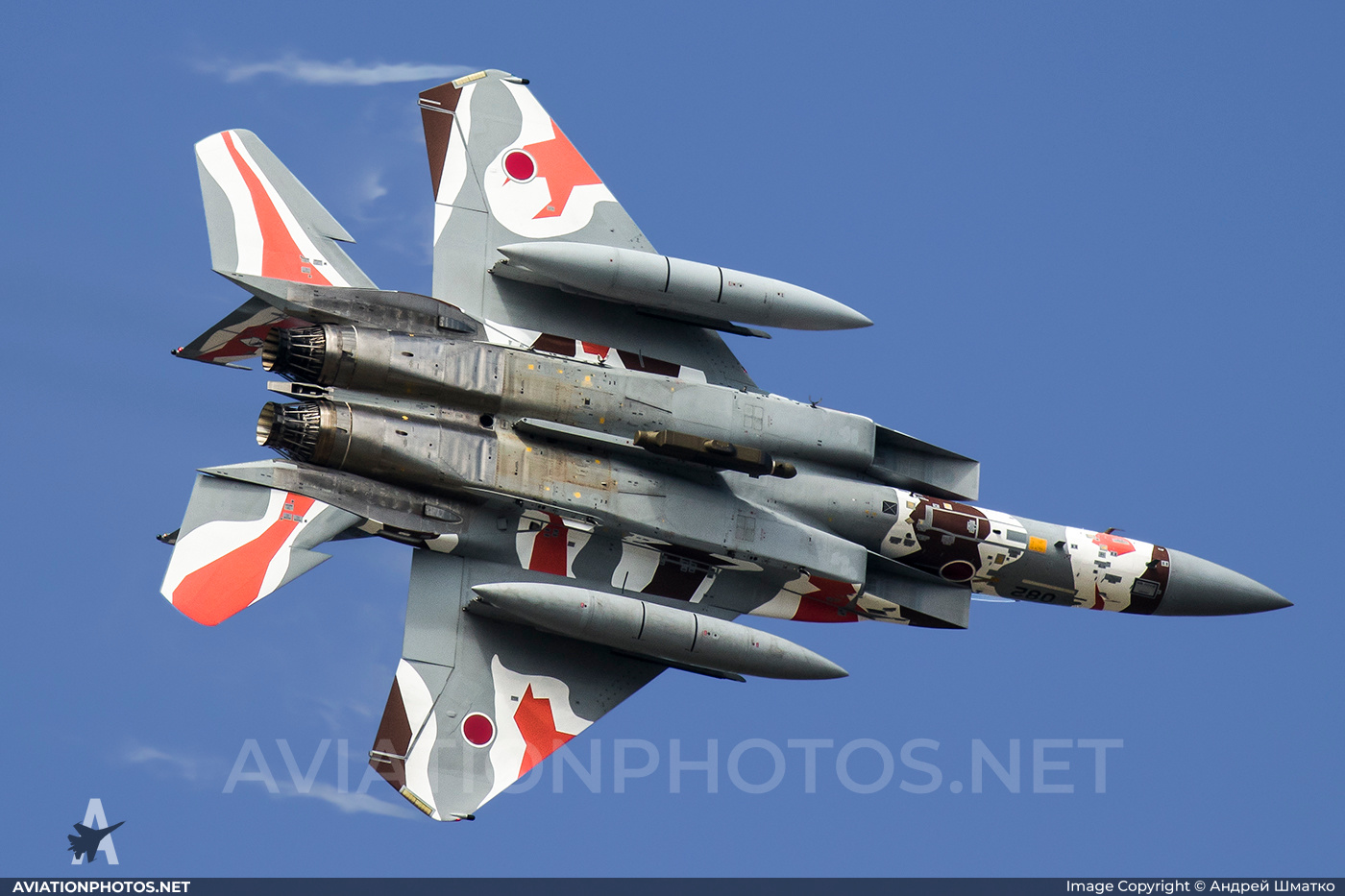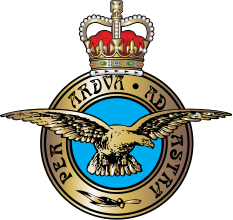
End of the Tornado RAF badge gone down in history

A Tornado GR.4A (foreground) with serial number ZG711 participated in the Tactical Leadership Program based at Florennes in Belgium in February 2006. The plane was lost
in the same year as a result of a bird strike.
The Tornado has been the primary fighter-bomber of the Royal Air Force (RAF) for the past forty years. The last machine of this type from combat flights in the Royal Air Force of Great Britain was withdrawn on March 31 this year. Today, the Tornado missions are being taken over by Eurofighter Typhoon FGR.4 and Lockheed Martin F-35B Lightning multipurpose aircraft.
The Chief of Staff of the Royal Netherlands Air Force, Lieutenant General Berti Wolf, launched a program in 1967 aimed at replacing the F-104G Starfighter and a qualitatively new fighter-bomber design, which was to be developed by the European Aviation Industry. Following this, the UK, Belgium, the Netherlands, Italy and Canada prepared a plan to create a multi-role combat aircraft (MRCA).
The MRCA requirement studies were completed on February 1, 1969. They were focused on strike capabilities and therefore the new aircraft had to be two-seat and twin-engine. In the meantime, the Dutch Ministry of Defense needed a light, single-engine, multi-role aircraft with an affordable purchase and operating cost. Due to conflicting, incompatible requirements, the Netherlands withdrew from the MRCA program in July 1969. Similarly, Belgium and Canada did the same, but the Federal Republic of Germany joined the program instead.
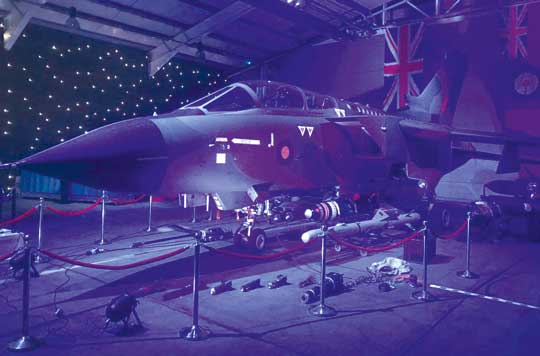
During the Cold War, Tornado GR.1 aircraft were adapted to carry WE 177 tactical nuclear bombs. On the ground: ALARM anti-radiation missile.
The efforts of the partners were focused on the development of an aircraft designed to strike at ground targets, conduct reconnaissance, as well as tasks in the field of air defense and tactical support for the forces of the Navy. Various concepts have been explored, including alternatives to single-engine fixed-wing aircraft.
The newly formed MRCA consortium decided to build prototypes; These were supposed to be two-seat multipurpose aircraft with a wide range of aviation weapons, including air-to-air guided missiles. The first prototype of such an aircraft took off at Manching in Germany on August 14, 1974. It has been optimized for ground strikes. Nine prototypes were used in the tests, and then six more experimental series aircraft. On March 10, 1976, a decision was made to start mass production of the Tornado.
Until the Panavia consortium (formed by British Aerospace, German Messerschmitt-Bölkow-Blohm and Italian Aeritalia) built the first pre-production aircraft, the MRCA was renamed Tornado. It first took off on February 5, 1977.
The first version for the Royal Air Force was called the Tornado GR.1 and differed slightly from the German-Italian Tornado IDS aircraft. The first Tornado GR.1 fighter-bomber was delivered to the multinational Trinational Tornado Training Establishment (TTTE) at RAF Cottesmore on 1 July 1980.
The unit has trained Tornado crews for all three partner countries. The first RAF line squadron equipped with the Tornado GR.1 was No. IX (Bomber) Squadron, formerly operating Avro Vulcan strategic bombers. In 1984, it was fully commissioned with new equipment.
Tasks and tactical and technical features
Tornado is a twin-engine multipurpose aircraft optimized for low-altitude clearance and bombardment of targets in the depths of enemy defenses, as well as for reconnaissance flights. In order for the aircraft to perform well at low altitude in the above tasks, it was assumed that it must achieve both high supersonic speed and good maneuverability and maneuverability at low speeds.
For high-speed aircraft in those days, a delta wing was usually chosen. But this type of wing is not effective for sharp maneuvering at low speeds or at low altitudes. As for low altitudes, we are mainly talking about the high drag of such a wing at high angles of attack, which leads to a rapid loss of speed and maneuvering energy.
The solution to the problem of having a wide range of speeds when maneuvering at low altitudes for the Tornado turned out to be a variable geometry wing. From the beginning of the project, this type of wing was chosen for the MRCA to optimize maneuverability and drag reduction at various speeds at low altitude. In order to increase the radius of action, the aircraft was equipped with a folding receiver for supplying additional fuel in flight.
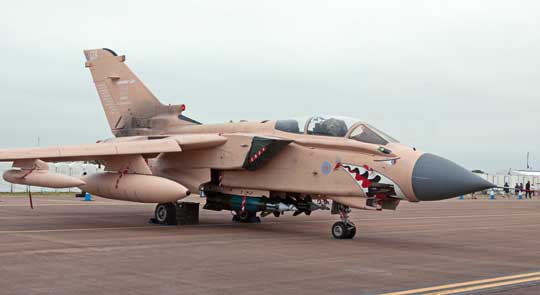
In 2015, a Tornado GR.4 with serial number ZG750 received the legendary 1991 Gulf War paint job known as "Desert Pink". Thus, the 25th anniversary of the combat service of this type of aircraft in British aviation was celebrated (Royal International Air Tattoo 2017).
In addition to the fighter-bomber variant, the RAF also acquired an extended hull length variant of the Tornado ADV fighter with different equipment and weapons, which in its final form bore the designation Tornado F.3. This version was used in the UK air defense system for 25 years, until 2011, when it was replaced by the Eurofighter Typhoon multirole aircraft.
characteristic
In total, the Royal Air Force had 225 Tornado aircraft in various attack variants, mainly in versions GR.1 and GR.4. As for the Tornado GR.4 variant, this is the last variant remaining in service with the RAF (the first copy of this variant was delivered to the British Air Force on October 31, 1997, they were created by upgrading earlier models), so in this article we will focus on the description of this particular variety.
The Tornado GR.4 fighter-bomber was systematically modified, still increasing its combat capabilities. Thus, the Tornado GR.4 in its final form is very different from those Tornados that were originally built in accordance with the tactical and technical requirements developed at the end of the 4s. Tornado GR.199 aircraft are equipped with two Turbo-Union RB.34-103R Mk 38,5 bypass turbojet engines with a maximum thrust of 71,5 kN and 27 kN in afterburner. This allows you to take off with a maximum takeoff weight of 950 1350 kg and reach speeds of up to 1600 km/h at low altitude and XNUMX km/h at high altitude.
The flight range of the aircraft is 3890 km and can be increased by in-flight refueling; range in a typical strike mission - 1390 km.
Depending on the task performed, the Tornado GR.4 can carry Paveway II, III and IV laser and satellite-guided bombs, Brimstone air-to-ground missiles, Storm Shadow tactical cruise missiles, and small air-to-air guided missiles. ASRAAM missile coverage. The Tornado GR.1 aircraft was permanently armed with two 27 mm Mauser BK 27 cannons with 180 rounds per barrel, which were dismantled in the GR.4 version.

In the first period of service, the Tornado GR.1 fighter-bombers of the RAF wore dark green and gray camouflage.
In addition to armament, the Tornado GR.4 aircraft carries additional fuel tanks with a capacity of 1500 or 2250 liters on an external sling, a Litening III optoelectronic surveillance and guidance tank, a Raptor visual reconnaissance tank, and a Sky Shadow active radio interference system. tank or ejectors of anti-radiation and thermodestructive cartridges. The maximum load capacity of the aircraft's external suspension is about 9000 kg.
With these weapons and special equipment, the Tornado GR.4 fighter-bomber can attack all targets that can be found on the modern battlefield. To combat objects with known positions, laser and satellite-guided Paveway family bombs or Storm Shadow tactical cruise missiles (for targets of key importance to the enemy) are usually used.
In operations involving independent search and countering ground targets or close air support missions for ground forces, the Tornado carries a combination of Paveway IV bombs and Brimstone air-to-ground guided missiles with a dual-band homing system (laser and active radar) together with an optical-electronic unit for observing and aiming tanks Litening III.
RAF Tornadoes have had various camouflage patterns since entering service. The GR.1 version came in a camouflage pattern consisting of olive green and gray spots, but in the second half of the nineties this coloration was changed to dark gray. During operations over Iraq in 1991, part of the Tornado GR.1 received a pink and sand color. During another war with Iraq in 2003, the Tornado GR.4 was painted light grey.
Proven in battle
During his long service in the Royal Air Force, the Tornado took part in many armed conflicts. Tornado GR.1 aircraft underwent baptism of fire during the Gulf War in 1991. About 60 RAF Tornado GR.1 fighter-bombers took part in Operation Granby (UK participation in Operation Desert Storm) from Muharraq base in Bahrain and Tabuk and Dhahran in Saudi Arabia. Arabia.
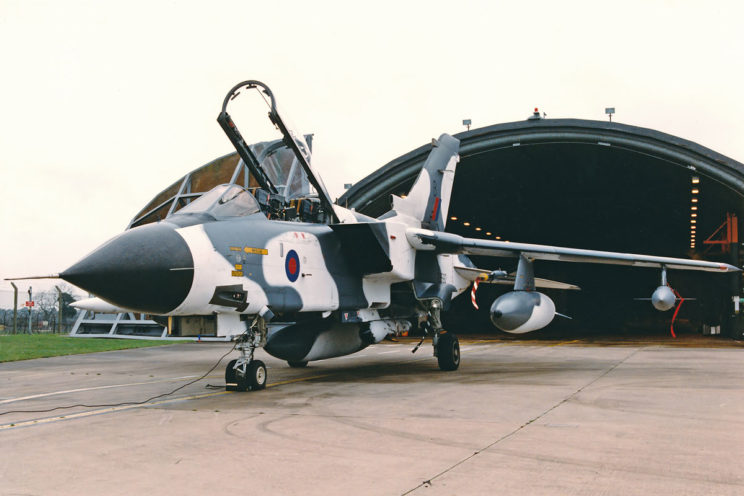
The British "Tornado", distinguished by the "Arctic" color, systematically took part in the exercises in Norway. Some of them were equipped with a reconnaissance tray with a line scanner operating in infrared and aerial cameras.
During the short but intense Iraqi campaign of 1991, the Tornado was used for low-altitude attacks on Iraqi airbases. In a number of cases, the then new optical-electronic surveillance and aiming cartridge TIALD (thermal imaging airborne laser target designator) was used, which was the beginning of the use of high-precision weapons on the Tornado. More than 1500 sorties were flown, during which six aircraft were lost.
18 Tornado F.3 fighters also participated in Operations Desert Shield and Desert Storm to provide air defense for Saudi Arabia. Since then, British Tornadoes have been almost constantly involved in hostilities, starting with the use in the Balkans as part of the enforcement of a no-fly zone over Bosnia and Herzegovina, as well as over northern and southern Iraq.
Tornado GR.1 fighter-bombers also took part in Operation Desert Fox, a four-day bombardment of Iraq from December 16 to 19, 1998 by US and British forces. The main reason for the bombing was Iraq's failure to comply with the recommendations of UN resolutions and the prevention of inspections by the UN Special Commission (UNSCOM).
Another combat operation in which the Royal Air Force Tornado took an active part was Operation Telek, the British contribution to Operation Iraqi Freedom in 2003. These operations included both the unmodified GR.1 Tornado and the already upgraded GR.4 Tornado. The latter had a wide range of precision strikes against ground targets, including the delivery of Storm Shadow missiles. For the latter, it was a combat debut. During Operation Telic, one aircraft was lost, mistakenly shot down by an American Patriot anti-aircraft system.
As soon as the Tornado GR.4 completed operations in Iraq, in 2009 they were sent to Afghanistan, where the Harrier attack fighters “relaxed”. Less than two years later, the UK, with an Afghan Tornado still in Kandahar, sent another Tornado into the Mediterranean. Along with the Eurofighter Typhoon aircraft based in Italy, the Tornado GR.4 from RAF Marham took part in Operation Unified Protektor in Libya in 2011.
It was an operation to enforce a UN-established no-fly zone to end attacks by Libyan government forces on armed opposition forces aimed at overthrowing the dictatorship of Muammar Gaddafi. The Tornado missions flew 4800 km from takeoff to landing, the first combat flights flown from British soil since the end of World War II. British participation in Operation Unified Defender was codenamed Ellamy |.
Losses
The P-08 prototype was lost during testing, the crew became disoriented in fog and the aircraft crashed in the Irish Sea near Blackpool. In total, during the 40-year service in the RAF, 78 vehicles out of 395 entered service were lost. Almost exactly 20 percent. Tornadoes are bought, on average two per year.
In most cases, the causes of accidents were various kinds of technical malfunctions. 18 aircraft were lost in mid-air collisions, and three more Tornados were lost when the crews lost control of the vehicle while trying to avoid a mid-air collision. Seven were lost in bird strikes and four were shot down during Operation Desert Storm. Of the 142 Tornado GR.4 fighter-bombers in service with the RAF between 1999 and 2019, twelve have been lost. This is about 8,5 percent. fleet, averaging one Tornado GR.4 in two years, but not a single aircraft has been lost in the last four years of service.
end
RAF GR.4 Tornados were constantly upgraded and improved, which gradually increased their combat capabilities. Thanks to this, modern Tornadoes are very different from those that began service in the British Air Force. These aircraft logged over a million flight hours and were the first to be retired by the RAF. The Tornado's best weapons, Brimstone air-to-air guided missiles and Storm Shadow tactical cruise missiles, now carry Typhoon FGR.4 multirole aircraft. The Typhoon FGR.4 and F-35B Lightning aircraft take on the tasks of the Tornado fighter-bomber, using the tactical experience gained by the crews and ground crews of these machines over forty years.

Two GR.4 Tornados just before takeoff for the next flight during the Frisian Flag exercise in 2017 from the Dutch base Leeuwarden. This was the last time the British Tornado GR.4 participated in the annual Red Flag equivalent of the American exercise.
The last British unit to be equipped with the Tornado GR.4 is No. IX(B) Squadron RAF Marham. From 2020, the squadron will be equipped with Protector RG.1 unmanned aerial vehicles. The Germans and Italians still use Tornado fighter-bombers. They are also used by Saudi Arabia, the only non-European recipient of this type of machine. However, all good things come to an end. Other Tornado users also plan to withdraw their aircraft of this type, which will happen by 2025. Then "Tornado" will finally go down in history.
